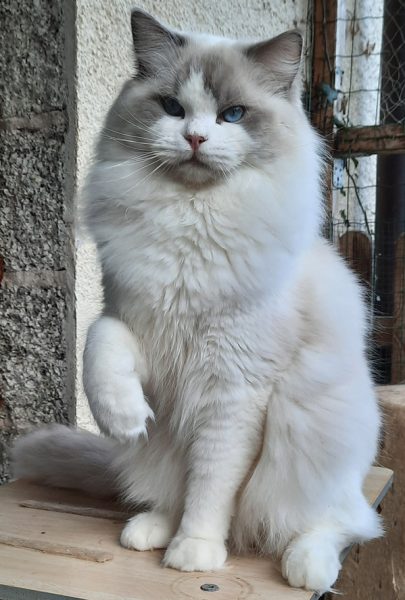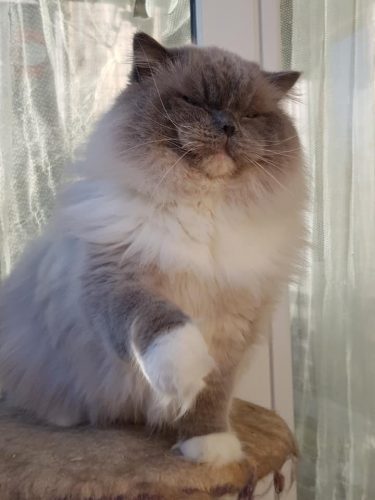About the Ragdoll

With positive reinforcement, Ragdoll cats learn quickly and can pick up tricks as well as good behaviors such as using a scratching post.
The Ragdoll cat is an all-around best buddy to just about everyone. They love their human families–even children–and will get along with other pets fairly well.
Docile, sweet, and happy to relax for a good cuddle session, the loving Ragdoll will even greet their humans at the door when they come home. If you’re looking for a companion, you can’t find a much better choice than one of these easygoing felines.
It’s important to remember that cats of any breed can suffer from health issues throughout their lives. A good pet insurance plan can help you prepare to give your cat the care they need at any age.
See all Ragdoll characteristics below!
Vital Stats:

Life Span:
12 to 17 years

Length:
17 to 21 inches, not including tail

Weight:
10 to 20 pounds

Origin:
Riverside, California, USA

Appearance
These beautiful cats are large and muscular with long hair and a soft, silky coat. Ragdolls are a low-shedding breed, but you may notice heavier seasonal shedding in the spring. The lack of an undercoat is to thank for this breed’s lack of shedding, but they are not considered to be a “hypoallergenic” cat.
These cats stand between 9–11 inches tall and are usually 17–21 inches in length (excluding their fluffy tail). They weigh 10–20 pounds, with male ragdoll cats typically weighing more, according to the Cat Fanciers’ Association.
According to the Ragdoll Fanciers Club, there are five types of ragdoll coat patterns: colorpoint, bicolor, mitted, lynx point, and tortie point.
Ragdoll colors include black, white, gray, blue, cream, lilac, chocolate, seal, and red. This breed is known to have blue eyes, but it is not an exclusive feature of the ragdoll.
Temperament
This adorable breed is about as docile as cats come. In fact, the name “ragdoll” comes from their tendency to go limp when picked up. These cats love to be held and babied and will relax in your arms for as long as you’ll let them.
RELATED: How to Pick Up and Hold a Cat the Right Way
The ragdoll’s personality is smart, gentle, and super affectionate. These kind kitties love and crave human attention, but they’re rarely demanding. Ragdolls are extremely loyal and devoted to their people, making them wonderful companion pets.
Living Needs
Ragdolls are generally easy to care for and a good fit for most families, kids, adults, and seniors, according to the Ragdoll Fanciers Club. This breed also gets along well with other pets. If you have the space to accommodate these big kitties, as well as tons of love to give them, they’ll make a wonderful addition to your household.
Your ragdoll can be left alone for short periods of time—say, a workday—but they’ll definitely miss you. These cats crave human attention and do best in households where one family member (or more!) is usually present during the day. A ragdoll frequently left at home without her humans will surely get lonely. And when you do leave for just a few short hours, don’t be surprised to come back and find your ragdoll patiently waiting at the door for you!
Personality
Unlike many cats, Ragdolls are notable for collapsing into the arms of anyone who holds them, even if they are cradled on their back. They love their people, greeting them at the door, following them around the house, and leaping into a lap or snuggling in bed whenever given the chance. They often learn to come when called or to retrieve toys that are thrown for them.
The word most often used to describe them is docile, but that doesn’t mean they are inactive. They like to play with toys and enter into any family activities. With positive reinforcement in the form of praise and food rewards when they do something you like, Ragdolls learn quickly and can pick up tricks as well as good behaviors such as using a scratching post. In a small, sweet voice, they remind you of mealtime or ask for petting but are not excessively vocal.
Ragdolls have nice manners and are easy to live with. You will find a Ragdoll on your sofa or bed, but generally not much higher than that. He prefers to stay on the same level with his people rather than the highest point in a room.
Care
A Ragdoll’s moderately long fur has little undercoat, which means it is less likely to mat and shed, but that doesn’t mean the cats need no grooming. Comb it twice a week with a stainless steel comb to remove dead hair that can cause tangles. Be sure to comb the fur on the legs thoroughly, especially where the leg meets the body, where mats are most likely to occur. A rubber curry brush will smooth the fur after you comb it and remove any remaining loose hairs. If you are gentle and don’t pull their hair, Ragdolls will love the attention they receive from you during grooming time.
Note that seasonal changes as well as hormonal fluctuations in unaltered cats can affect the length of the coat. The coat will be at its peak in winter. Ragdolls that have been spayed or neutered will usually have a lush coat year-round because they lack the hormonal fluctuations that occur in unaltered cats.
Health
Ragdoll cats have a lengthy lifespan of 13–18 years and are typically healthy pets.
The ragdoll’s greatest health risks include hypertrophic cardiomyopathy (HCM) and urinary tract issues. Reputable breeders will screen for health issues in your kitten, but it’s important to have them screened regularly into adulthood. HCM and other health problems can go undetected until later in your cat’s life.
